There are 22 turtles in North Carolina. 17 are freshwater turtles and 5 are endangered sea turtles. Some of North Carolina’s native turtles are protected, like the Bog turtle. Others are fairly widespread, such as the Eastern Box turtle which serves as North Carolina’s state reptile. The Red-eared Slider is a non-native invasive species.
The state is home to a variety of turtles with unique characteristics, including species with long necks, powerful jaws, and distinct markings like yellow spots. From the coastal regions of the Outer Banks to the inland habitats, this article will cover different types of turtles, such as loggerhead turtles, green turtles, and the diamond-backed terrapin, exploring their habitats in eastern North Carolina and beyond.
In this list we’ll explore each of these species in detail, as well as providing some information on their basic care requirements in case you’re considering one of these turtles as your next pet. This information can also be used as a herping field guide in case you spot one of these turtles in the wild.
It is illegal to keep the majority of native turtles as pets in North Carolina. The only species that you can own are the Eastern Mud turtle, Striped Mud turtle, Common Musk turtle, and the Common Snapping turtle. All other species are forbidden. We’ll still provide care information for these forbidden turtles in case you live in an area of the country where they are legal.
If you do want to obtain one of the legal pet turtle species in North Carolina, make sure to only adopt or buy a captive-bred specimen. Taking native turtles from the wild or releasing non-native species can negatively impact the local environment and other native animal populations.
Let’s take a look at the 21 turtle species native to North Carolina.
Turtles in North Carolina
Among the 17 species of freshwater turtles in North Carolina are the redbelly turtle and yellowbelly sliders, known for their vibrant underbelly colors. The state’s varied landscape, including small streams, salt marshes, and the unique environments of the Gulf Coast, provide ideal habitats for these turtles. This section will detail each species, including their top shell (carapace) and bottom shell (plastron) features.
Table of Contents
1. Bog Turtle

- Experience Level: Beginner
- Family: Emydidae
- Scientific Name: Glyptemys muhlenbergii
- Other Names: Muhlenberg’s turtle
- Adult Size: 3.5 to 5 inches
- Lifespan: Up to 40 years
- Average Price Range: $250 to $450
Bog turtles are North America’s smallest turtle species and are also known as Muhlenberg’s turtle. Unfortunately, they are a critically endangered species in many areas. In North Carolina, they are found in western counties.
These tiny turtles unsurprisingly prefer boggy habitats where they can hide in mud but can also be found in woodland regions. Bog turtles have keeled shells that range from olive or dark brown to black. Some of the scutes may have yellow or red star-like patterning. Their cheeks sport a distinctive bright orange or yellow patch.
If Bog turtles are legal in your area, they will need a 40-gallon tank or an enclosure measuring 3 feet by 2 feet. Provide lots of places to hide to help your turtle feel safe. The enclosure should have land and water areas. The water should not be deeper than the length of the turtle’s shell and should be kept at a temperature between 65°F and 75°F.
A good filter will be needed to keep the water clean, as Bog turtles can be messy. In the land area, leaf litter, mulch, and other soft, moist substrates are your best bet. The air temperature should remain between 75°F and 85°F, with a basking spot set up at 85°F to 90°F with a UVB light as well.
Bog turtles are omnivorous, with the majority of their diet coming from protein sources such as insects, fish strips, and worms. Supplement this with dark leafy greens and a few fruits and vegetables.
2. Eastern Box Turtle
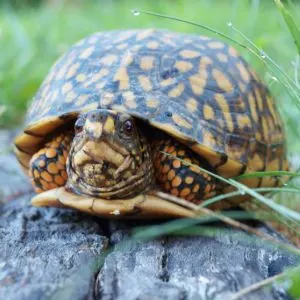
- Experience Level: Beginner
- Family: Emydidae
- Scientific Name: Terrapene carolina carolina
- Other Names: Land turtle
- Adult Size: 4 to 7 inches
- Lifespan: 40 to 100 years
- Average Price Range: $120 to $400
- Recommended Books: Box Turtles: Complete Herp Care (Tess Cook)
Eastern Box turtles are the state reptile of North Carolina and can be found all across the state. They have beautiful orange patterns across their dark shells and skin and are found mainly in grasslands, marshes, and woodland regions.
It is illegal to keep Eastern Box turtles as pets in North Carolina. However, if you live somewhere where they are legal, an adult specimen will need an enclosure measuring 4 feet wide by 18 inches high. An outdoor enclosure that mimics their natural habitat is the preferable setup for Eastern Box turtle.
The ambient temperature should be kept between 75°F and 80°F, with a basking spot of 85°F to 88°F. Humidity should be kept at around 70% using moist substrates such as mulch, with enough depth for the turtle to bury itself.
Eastern Box turtles need both heat and UVB light if being kept indoors. Any lights should be kept on a 12-hour day/night cycle. If kept outdoors, make sure that one area of the enclosure receives some direct sunlight Eastern Box turtles don’t really like being handled, so avoid this is possible.
Eastern Box turtles are omnivores and require eat a varied diet of dark greens, vegetables, and protein such as crickets, earthworms, mealworms, and mollusks.
3. Eastern Chicken Turtle

- Experience Level: Intermediate
- Family: Emydidae
- Scientific Name: Deirochelys reticularia reticularia
- Other Names: American Snake-necked turtle
- Adult Size: 4 to 10 inches
- Lifespan: 15 to 30 years
- Average Price Range: $130 to $200
Eastern Chicken turtles are medium-sized semi-aquatic turtles found in wetland areas with slow-moving waters in the eastern and southeastern counties of North Carolina. These turtles have green shells and yellow net-like markings and long, striped necks.
It is illegal to possess an Eastern Chicken turtle as a pet in North Carolina, but if you do live in an area where you can keep them legally, read on for some basic care information.
Eastern Chicken turtles need an aquatic setup with a small land area for basking. Males will need a 75-gallon tank while females require a 125-gallon tank. They prefer slow-moving water but will still need an adequate filtration system.
The ambient temperature should be maintained between 70°F and 80°F, whilst the water temperature needs to remain in the mid-70s. A basking spot of between 85°F and 90°F is ideal. Decorate the tank with artificial or live plants along with rocks to generate some cover for your turtle.
Eastern Chicken turtles will also need a UVB light along with their heat lamp. Keep the lights on a 12-hour day/night cycle. Eastern Chicken turtles are mainly carnivorous, eating crustaceans, small fish, and worms. To keep their diet varied, offer some dark leafy greens as well.
4. Eastern River Cooter
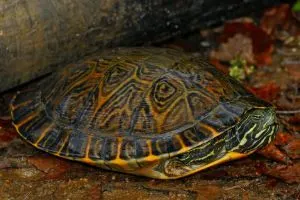
- Experience Level: Beginner to Intermediate
- Family: Emydidae
- Scientific Name: Pseudemys concinna
- Other Names: N/A
- Adult Size: 8 to 16 inches
- Lifespan: 20 to 40 years
- Average Price Range: $20 to $50
- Recommended Books: Aquatic Turtles: Sliders, Cooters, Painted, and Map Turtles (R.D. Bartlett)
Eastern River Cooters are a large freshwater aquatic species found in fast-moving rivers and streams across the eastern half of North Carolina. These Cooters have dark green shells with C-shaped markings on their lower scutes.
It is illegal to possess or sell Eastern River Cooters in North Carolina, but if you do live somewhere where they are legal captives, you’ll need a large outdoor pond or a 300-gallon stock tank. These enclosures need powerful filtration to keep waste down and around 1 to 2 feet of water for adults.
The water temperature should be kept close to 75°F, with an out of water basking spot kept at 85°F. If you’re keeping your Eastern River Cooter indoors, you’ll also need to provide UVB light on a 12-hour day/night cycle.
River Cooters are mostly herbivores, so their diet should consist of dark leafy greens such as collard greens, dandelions, and romaine lettuce. You can also provide some aquatic plants in their enclosures.
5. Florida Cooter

- Experience Level: Beginner to Intermediate
- Family: Emydidae
- Scientific Name: Pseudemys floridana
- Other Names: Coastal Plain Cooter
- Adult Size: 8 to 12 inches
- Lifespan: 20 to 40 years
- Average Price Range: $20 to $50
- Recommended Books: Aquatic Turtles: Sliders, Cooters, Painted, and Map Turtles (R.D. Bartlett)
Florida Cooters are semi-aquatic, freshwater turtles found across the eastern half of North Carolina. They prefer coastal plains and rivers or swamps with sandy bottoms. They can sometimes be seen basking in social groups, usually on logs above the water.
Florida Cooters have a relatively flat shape compared to other Cooters. They have dark green shells with swirling orange patterning. Although they look similar to Eastern River Cooters, Florida Cooters do not have C-shaped markings on their shells.
Like many of North Carolina’s native turtles species, it is illegal to keep Florida Cooters as pets in the state. However, if you do live in an area where they can be obtained legally, their care requirements are virtually the same as Eastern River Cooters above.
6. Northern Red-bellied Cooter

- Experience Level: Beginner to Intermediate
- Family: Emydidae
- Scientific Name: Pseudemys rubriventris
- Other Names: N/A
- Adult Size: Between 8 and 12.5 inches
- Lifespan: Between 40 and 55 years
- Average Price Range: Between $30 and $170
- Recommended Books: Aquatic Turtles: Sliders, Cooters, Painted, and Map Turtles (R.D. Bartlett)
Northern Red-bellied Cooters are a large aquatic species and are cautious and shy. These turtles are found only in a few extreme eastern counties of North Carolina, preferring rivers and ponds with soft bottoms. They can occasionally be found in brackish waters.
Northern Red-bellied Cooters are easily identified by their eponymous red colored underbellies. They also have reddish lines on some of the scutes on their shells, which range from olive green to black.
It is illegal to keep Northern Red-bellied Cooters as pets in North Carolina. If you live in a state where they are a legal species, they will have similar care requirements to the other Cooters listed above.
Give these Cooters a large tank of around 300-gallons, with a strong but slow-moving filtration system and a basking spot out of the water. Keep their temperatures consistent and feed them a herbivorous diet.
7. Diamondback Terrapin
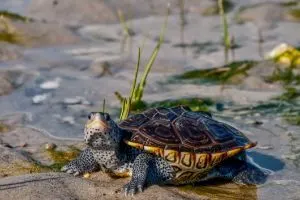
- Experience Level: Beginner to Intermediate
- Family: Emydidae
- Scientific Name: Malaclemys terrapin (various)
- Other Names: N/A
- Adult Size: 4.5 to 5.5 inches (Males) and 6 to 9 inches (Females)
- Lifespan: 25 to 40 years
- Average Price Range: $250 to $300
- Recommended Books: Map Turtles and Diamondback Terrapins (W.P. Mara)
Diamondback terrapins are a beautiful species of turtle found in brackish waters or estuaries. There are two subspecies of Diamondback terrapins in North Carolina; the Carolina Diamondback terrapin (Malaclemys terrapin centrata) and the Northern Diamondback terrapin (Malaclemys terrapin terrapin).
These turtles are found only along coastal waters of North Carolina and rarely venture far inland. They have stunning diamond-shaped patterns on their shells and distinctive light gray skin with black speckles. It is illegal to own either type of native Diamondback terrapin in North Carolina.
If you do live somewhere where you are able to own a Diamondback terrapin, they have some specific care requirements. They need brackish water to recreate their natural habitat, which is freshwater with a small amount of salt in it. This can be tricky to get right.
A Diamondback terrapin needs between 80 and 100-gallons of tank space with good filtration. The water should be maintained at around 70°F, while the ambient air temperature should be around 80°F.
A basking spot of 90°F with a UVB bulb as well will also be needed. Diamondback terrapins are largely carnivorous, and should be fed crustaceans, mollusks, worms, and commercial turtle diets. A small amount of aquatic vegetation or dark leafy greens should also for a varied diet.
8. Eastern Mud Turtle
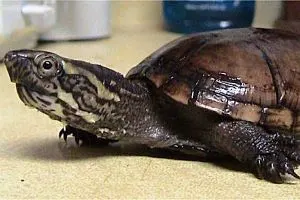
- Experience Level: Beginner
- Family: Kinosternidae
- Scientific Name: Kinosternon subrubrum
- Other Names: Common Mud turtle
- Adult Size: 3 and 5 inches
- Lifespan: Up to 50 years
- Average Price Range: $40 to $100
Eastern Mud turtles are small aquatic turtles that are infamous for their sharp beaks and aggressive nature when they feel provoked. Keep this in mind when considering this species as a pet. These are one of the native North Carolina species that can be kept legally.
Eastern Mud turtles across most of North Carolina except for western regions. They reside in lakes, ponds, rivers, and swamps. Despite their small size, these turtles actual need a lot of swimming room, and you should house your turtle in at least a 40-gallon tank.
Use a gravel substrate to allow your Eastern Mud turtle to burrow or walk along the bottom of the tank. These turtles are famous for being messy eaters, so you’ll need a strong filter setup. Eastern Mud turtles are omnivores and should have a staple diet of insects, mollusks, and worms along with dark green leafy vegetables.
Eastern Mud turtles require a water temperature of about 75°F and an air temperature ranging between 75°F and 80°F. A basking spot should also be provided and kept at around 90°F to 95°F, along with a UVB light on a 12-hour day/night cycle.
9. Striped Mud Turtle

- Experience Level: Beginner
- Family: Kinosternidae
- Scientific Name: Kinosternon baurii
- Other Names: N/A
- Adult Size: 4 to 5 inches
- Lifespan: Up to 50 years
- Average Price Range: $75 to $160
Striped Mud Turtles are a small species of aquatic turtle found across the eastern half of North Carolina. Striped Mud turtles have dark brown oval-shaped shells with three yellowish vertical stripes. They are mainly found in still waters such as swamps and wetlands and often bury themselves under leaf litter.
Striped Mud turtles can be kept legally in North Carolina and need a minimum tank size of 20-gallons to give them plenty of room to swim. A small area of the tank should have a land setup and a basking spot. Aquatic plants are good tank decorations to use.
Keep the water temperature between 70°F and 75°F. The basking spot needs to be around 85°F to 90°F. A UVB light is also required to keep your turtle healthy. Use an underwater heater if needed. You’ll need a strong filtration system, preferably with three stages.
Striped Mud turtles are omnivores and should be feed insects, mealworms, and some leafy greens for variety. They can be messy eaters, so keep this in mind and do a spot clean after feeding time.
10. Common Musk Turtle

- Experience Level: Intermediate
- Family: Kinosternidae
- Scientific Name: Sternotherus odoratus
- Other Names: Eastern Musk turtle, Stinkpot
- Adult Size: 4 to 5 inches
- Lifespan: 40 to 60 years
- Average Price Range: $50 to $100
- Where To Buy: theturtlesource.com, undergroundreptiles.com
Common Musk turtles are small nocturnal turtles found all across North Carolina in slow-moving waters with dense aquatic vegetation and soft bottoms. Common Musk turtles can release a potent odor from their musk glands when threatened, earning them the nickname of “Stinkpots”.
Common Musk turtles have dark brown or black unmarked shells. Their heads are also dark, with two yellowish stripes running down their cheeks and fleshy barbels on their chins and necks. They can be kept legally as captive pets in North Carolina.
A 20-gallon tank is a good size for these small turtles. They need a strong filtration system as they make a lot of mess while eating. Common Musk turtles are omnivorous and do well on a varied diet of insects, fish strips, and worms along with commercial turtle pellets and some leafy greens.
Common Musk turtles require a basking spot that is kept at about 90°F. This spot should also have a UVB light that is maintained on a 12-hour day/night cycle. Water temperature should be kept between 72°F and 78°F.
11. Stripe-necked Musk Turtle

- Experience Level: Intermediate
- Family: Kinosternidae
- Scientific Name: Sternotherus minor peltifer
- Adult Size: 3 to 4.5 inches
- Lifespan: 20 to 50 years
- Average Price Range: $100 to $250
Stripe-necked Musk turtles are a subspecies of the Loggerhead Musk turtle (Sternotherus minor). These small turtles are aquatic and have larger heads than other types of Musk turtles. Stripe-necked Musk turtles have green shells and bold stripes running down their heads and necks.
Stripe-necked Musk turtles are a species of Special Concern in North Carolina and are only found in two extreme western counties close to the border with Tennessee. They prefer mountainous rivers or streams. It is illegal to keep a Stripe-necked Musk turtle as a pet in North Carolina.
If you live in a state where these turtles can be kept legally, they need a lot of swimming room and require a minimum tank size of 30-gallons. They will also need a basking spot of around 85°F to 90°F along with a UVB light.
The water temperature for Stripe-necked Musk turtles should be maintained at around 70°F, with an ambient air temperature of 75°F to 83°F. Provide some cover in the form of aquatic plants and rocks.
Stripe-necked Musk turtles are carnivorous and should be fed insects, mollusks, worms, and commercial turtle pellets such as Mazuri or ReptoMin. Snails are a particular favorite. Some leafy greens should be offered occasionally for variety.
12. Eastern Painted Turtle
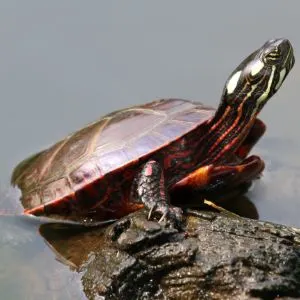
- Experience Level: Beginner
- Family: Emydidae
- Scientific Name: Chrysemys picta picta
- Other Names: N/A
- Adult Size: 4 to 10 inches
- Lifespan: 30 to 50 years
- Average Price Range: $80 to $140
- Recommended Books: Painted Turtle Pet Owners Guide (Ben Team)
Eastern Painted turtles are a common species found across much of the eastern United States. In North Carolina, these turtles are found in most counties except for southern regions. They like slower-moving waters such as lakes and ponds.
Eastern Painted turtles have dark shells that are often edged in colors ranging from yellow to red. Their faces also sport bold yellow stripes. It is illegal to own Eastern Painted turtles in North Carolina.
If you do live somewhere where these turtles are legal, you’ll need an 100-gallon at minimum. There should be a land area formed of large flat rocks which acts as a basking spot along with a UVB light. The basking spot should be maintained between 85°F and 95°F.
A strong filtration system is essential for Eastern Painted turtles. The water temperature needs to be kept at around 75°F to 80°F, while ambient air temperature should remain between 80°F and 85°F.
Eastern Painted turtles are omnivores, so feed them commercial pellets, crickets, insects, and worms along with supplemental dark leafy greens or aquatic vegetation in their tanks.
13. Red-eared Slider

- Experience Level: Beginner
- Family: Emydidae
- Scientific Name: Trachemys scripta elegans
- Other Names: Water Slider turtle, Red-eared Terrapin
- Adult Size: 6 to 8 inches
- Lifespan: 20 to 40 years
- Average Price Range: $15 to $50
- Recommended Books: Red Eared Slider Owners Manual (David Donalton)
The Red-eared Slider is a common species used in the pet turtle trade. This turtle is considered to be an invasive species as it is are not native to North Carolina. However, it has been introduced through the unsafe release of captive specimens. It is illegal to own a Red-eared Slider in North Carolina without a permit.
Red-eared Sliders are found in slow-moving warm waters and marshes. They are strong swimmers and spend the majority of their time underwater. A 40-gallon tank is the minimum size for these turtles as they need a lot of swimming space. Use a gravel substrate that is large enough to avoid the risk of being swallowed by your Slider.
Red-eared Sliders like to bask regularly, so provide a dock for your turtle to bask on. Keep the basking spot at 95°F. The water temperature should be kept at around 75°F and the tank should have a strong a strong filter setup.
Provide a UVB light set on a 12-hour day/night cycle. Red-eared Sliders do not like frequent handling and may bite if they feel threatened. They need an omnivorous diet consisting of crickets, crustaceans, pellets, mollusks, and worms as well as leafy greens.
14. Yellow-bellied Slider
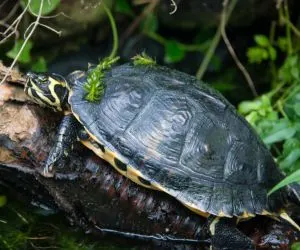
- Experience Level: Beginner
- Family: Emydidae
- Scientific Name: Trachemys scripta scripta
- Other Names: N/A
- Adult Size: 5 to 12 inches
- Lifespan: 20 to 40 years
- Average Price Range: $15 to $50
- Recommended Books: Aquatic Turtles – Complete Herp Care (David T. Kirkpatrick)
Yellow-bellied Sliders are spend most of their time in the water and can be found across a wide range of habitats across the eastern half of North Carolina. It is illegal to keep these turtles as pets in North Carolina.
As their name implies, these turtles have yellowish plastrons and markings across their skin. Yellow-bellied Sliders also have prominent yellow stripes behind their eyes. Their shells range from dark brown to olive.
If you can keep Yellow-bellied Sliders legally in your state, keep in mind that this species needs a huge amount of space. Ideally, you should house them in an outdoor pond. Failing that, a 75 to 100-gallon tank is the minimum size needed.
Yellow-bellied Sliders need a large basking spot that includes a UVB lamp. The basking bulb needs to be kept between 80°F and 100°F. These turtles can also be messy at times, so a powerful filtration system is needed. The water temperature needs to be maintained somewhere between 75°F and 80°F. Use a water heater day and night if necessary.
Yellow-bellied Slider are omnivores and should eat a diet of commercial pellets, crickets, insects, mollusks, and worms. Offer some dark leafy greens as well to give them a varied diet.
15. Common Snapping Turtle
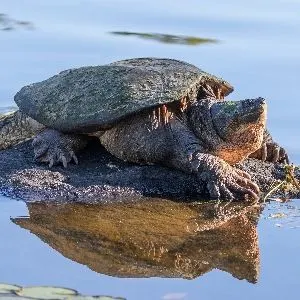
- Experience Level: Intermediate to Expert
- Family: Chelydridae
- Scientific Name: Chelydra serpentina
- Other Names: Common Snapper, Eastern Snapping turtle, Snapper
- Adult Size: 8 to 20 inches
- Lifespan: 30 to 50 years
- Average Price Range: $20 to $40
- Recommended Books: Snapping Turtle Pet Owners Guide (Ben Team)
Common Snapping turtles are a large, freshwater species that are found all across North Carolina in larger bodies of water like lakes. These turtles can be very aggressive. Only experienced turtle owners should even consider keeping a Common Snapping turtle.
Common Snapping turtles are easily identified by their distinctive hooked jaws. They usually have dark brown or green shells with thick ridges. They also have strong claws and long tails covered with saw-toothed spines.
These large turtles can be kept legally as pets in North Carolina. To contain a fully-grown Snapper, you’ll need to use something like a 300-gallon stock tank or an outdoor pond. An external filter will be needed to help keep the tank clean without the risk of being damaged by the turtle.
If you’re keeping your Snapper indoors, you’ll need to provide a UVB light positioned above the water surface, as Common Snappers will float at the surface while basking. The water temperature should be maintained at 80°F.
Common Snappers are prefer a more meat-based diet of small amphibians, fish, insects, and mollusks and worms. You can also offer them aquatic plants or dark leafy greens.
16. Spiny Softshell Turtle
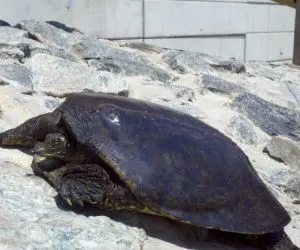
- Experience Level: Intermediate to Expert
- Family: Trionychidae
- Scientific Name: Apalone spinifera (various)
- Other Names: N/A
- Adult Size: 5 to 9.5 inches (Males), 7 to 19 inches (Females)
- Lifespan: 20 to 50 years
- Average Price Range: $70 to $280
- Recommended Books: Spiny Softshell Turtle Guide (Ben Team)
There are two subspecies of Spiny Softshell turtles found in North Carolina; the Eastern Spiny Softshell (Apalone spinifera spinifera) and the Gulf Coast Spiny Softshell (Apalone spinifera aspera). They are both found in a few southwestern areas of North Carolina.
Spiny Softshells have leathery pancake-like shells with small spines. Gulf Coast Spiny Softshells can be distinguished from Eastern Spiny Softshells due to theseries of black bars running around the rim of their shells, with ring-like markings on the upper shell. Carapace colors for both subspecies range from brown to tan.
Neither subspecies is can be legally kept as pets in North Carolina. But if you live in an area of the country where they are legal, these turtles will need a 75 to 100-gallon tank at a minimum. A powerful filter is needed to create a fast-moving current, and the substrate should be mud or fine sand to replicate their preferred habitat of rivers with sandy bottoms.
Water temperature should range from 70°F to 80°F, with a water heater being deployed if necessary. Spiny Softshells require a basking spot and a UVB light with a floating basking platform or a small terrestrial area underneath. The basking temperature should be between 85°F and 88°F.
Gulf Coast Spiny Softshells should be fed crickets, insects, fish, mollusks, and worms as part of a carnivorous diet. They can also eat commercial pellets. This species doesn’t tolerate handling very well.
17. Spotted Turtle

- Experience Level: Intermediate to Expert
- Family: Emydidae
- Scientific Name: Clemmys guttata
- Other Names: N/A
- Adult Size: 4 to 5 inches
- Lifespan: 25 to 50 years
- Average Price Range: $75 to $100
- Recommended Books: BASICS – Ecology, Husbandry & Breeding Spotted & Wood Turtles (Andreas S. Hennig)
The Spotted turtle is a small semi-aquatic species found mainly bogs, swamps, and wetland habitats in the eastern half of North Carolina. Their smooth shells are black and covered with their eponymous bright yellow dots.
Although they are illegal in North Carolina, It is possible to keep this beautiful species as a pet in other areas of the country. You’ll need a 20-gallon tank at minimum which should be set up with both land and shallow water areas with logs and plants for cover. The water shouldn’t be deeper than the turtle’s head.
Water temperature should be maintained between 75°F and 80°F, and the basking area should be kept between 90°F to 95°F. A UVB light should also be provided on a 12-hour day/night cycle. A good filtration system is needed as this species can be messy when eating.
Spotted turtles prefer a more carnivorous diet and should be fed crustaceans, insects, mollusks, and worms. Offer small amounts of aquatic vegetation or dark leafy greens to keep the diet varied and healthy.
There are also five species of Sea turtles that can be seen off the coastline of North Carolina. All of these species are endangered, and cannot be kept as pets anywhere in the United States. We’ll still take a look at each turtle with the aim of providing a field guide in case you’re luck enough to spot one in the wild.
Sea Turtles in North Carolina
In addition to freshwater species, North Carolina’s beaches, such as those at Bald Head Island, Caswell Beach, and Sunset Beach, are crucial nesting grounds for sea turtles. The conservation efforts under the Endangered Species Act, particularly for sea turtle nests, are significant in maintaining healthy populations. The North Carolina Wildlife Resources Commission plays a vital role in these conservation efforts.
18. Green Sea Turtle

- Family: Cheloniidae
- Scientific Name: Chelonia mydas
- Other Names: N/A
- Adult Size: 3 to 4 feet
- Weight: 300 to 400 lbs
- Lifespan: 80 to 100 years
- Conservation Status: Endangered
- Habitat: Bays and shores along coastlines and open ocean waters, seen during summer months
- Clutch Size: Around 110 to 115 eggs, with 2 to 5 clutches per breeding season
- Food: Mostly herbivores, eating algae, sea grasses and seaweed
- Appearance: Smooth green to brown shells shaped like hearts, edged in yellow. Cream colored scaly skin with shades of green
Green Sea turtles are one of the world’s largest turtle species, weighing an average of 350 pounds and growing up to 4 feet in length. These herbivores mainly eat algae and seagrasses. These beautiful but endangered turtles face several threats such as sea pollution and being trapped in fishing nets.
19. Hawksbill Sea Turtle
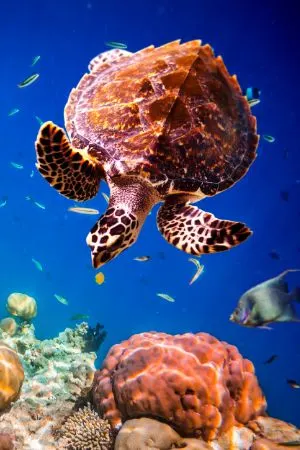
- Family: Cheloniidae
- Scientific Name: Eretmochelys imbricata
- Other Names: Atlantic Hawksbill Sea turtle
- Adult Size: 30 to 35 inches
- Weight: 100 to 155 lbs
- Lifespan: 30 to 50 years
- Conservation Status: Critically Endangered
- Habitat: Shallow coastal areas of rocky or tropical waters, reefs and estuaries
- Clutch Size: Between 140 to 200 eggs, about 4 clutches per breeding season
- Food: Omnivores, mainly consuming crustaceans, mollusks, and algae
- Appearance: Prominent, beak-shaped mouths (like a hawk), oval shells in shades of amber with unique markings. Flippers also have claws at their “elbows”
North Carolina’s coast, part of the broader East Coast, is a pivotal area for marine turtle life cycles. Hawksbill turtles, known for their brown eyes and unique shell pattern.
Hawksbill Sea turtles are critically endangered, with only 8,000 nesting females found across the globe. Hawksbill Sea turtles are sadly confronted with threats such as water pollution as well as being trapped in fishing nets or lines.
20. Kemp’s Ridley Sea Turtle

- Family: Cheloniidae
- Scientific Name: Lepidochelys kempii
- Other Names: Atlantic Ridley Sea turtle
- Adult Size: Around 25 inches
- Weight: 75 to 100 lbs
- Lifespan: Around 30 years
- Conservation Status: Critically Endangered
- Habitat: Sandy or muddy coastlines with shallow waters
- Clutch Size: Between 100 and 110 eggs, 2 to 3 clutches per breeding season
- Food: Crustaceans, shellfish
- Appearance: Slightly hooked beaks, triangle-shaped heads. Green to gray round shells. Muted cream or yellow plastrons and undersides.
Kemp’s Ridley Sea turtles are the most endangered species of Sea turtle in the world. They can travel hundreds of miles to migrate to their preferred nesting sites.
21. Leatherback Turtle

- Family: Dermochelyidea
- Scientific Name: Dermochelys coriacea
- Other Names: N/A
- Adult Size: 6 to 7 feet
- Weight: 550 to 1500 lbs
- Lifespan: Around 30 years
- Conservation Status: Vulnerable
- Habitat: Warm waters, mainly shallow, calm bays or lagoons. Nests common on sandy beaches.
- Clutch Size: 100 to 110 eggs
- Food: Jellyfish is the staple of their diet, but they will also eat other sea creatures
- Appearance: Their large carapaces are soft, unique among sea turtles, with prominent ridges all the way down. Colors vary between black and a dark gray.
Leatherback Sea turtles are the largest turtle species on the planet, weighing up to 1500 lbs. These immense animals prefer the deepest and coldest waters of any Sea turtle and have the longest migration route. They are the only Sea turtle species that doesn’t have a hard outer shell.
22. Loggerhead Sea Turtle

- Family: Cheloniidae
- Scientific Name: Caretta caretta
- Other Names: N/A
- Adult Size: 30 to 45 inches
- Weight: Approximately 155 pounds
- Lifespan: 70 to 80 years
- Conservation Status: Endangered
- Habitat: Coastal regions, mainly shallow bays. Prefer sub-tropical waters. Sandy ocean beaches for nesting
- Clutch Size: Between 100 and 125 eggs, 4 to 5 clutches per breeding season
- Food: Carnivorous, mainly eating shellfish, mollusks, and crustaceans
- Appearance: Largest hard-shelled turtles with a reddish-brown carapace and large heads. Undersides are cream to yellowish. Long powerful flippers
Loggerhead Sea turtles are the most common Sea turtle species observed across the coast of America. These turtles swim thousands of miles to reach these prime nesting sites. Loggerhead Sea turtle populations are sadly decreasing due to being accidentally captured in fishing nets or traps.
Conservation and Habitat Loss
The conservation of turtles in North Carolina, from box turtle populations to aquatic invertebrates, is increasingly challenged by habitat loss. The smallest species of turtles in the state, often found in unique habitats like salt marshes and small ponds, are particularly vulnerable. Understanding the habitat requirements and threats facing these species, such as the pond turtle with its red eyes, is crucial for their continued survival.
Wrapping up
In conclusion, North Carolina’s diverse range of turtle species, from the smallest to the largest, reflects the state’s rich ecological tapestry. The ongoing conservation efforts, addressing issues like habitat loss and the protection of endangered species, are vital. Whether you’re a prospective turtle owner or a nature enthusiast, understanding the unique characteristics and needs of these turtles is essential for their preservation.
So that wraps up our list of the turtles that you can find in North Carolina. We’ve looked at several freshwater turtles such as Eastern Box turtles, Common Musk turtles, and Spotted turtles as well as five species of endangered Sea turtles that can be spotted off the shores of North Carolina.
While most of the native turtles of North Carolina cannot be kept legally as pets within the state, we provided basic care information in case you live somewhere where they are legal.
Remember, the only native legal pet species in North Carolina are the Eastern Mud turtle, Striped Mud turtle, Common Musk turtle, and Common Snapping turtle.
If you enjoyed this list and are thinking about choosing one of these turtles as your next pet, don’t hesitate to comment down below!
Other nearby states
- Turtles in Georgia
- Tortoises in Georgia
- Turtles in South Carolina
- Turtles in Tennessee
- Turtles in Virginia
